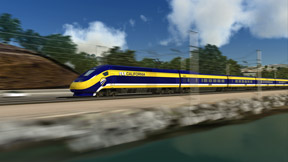I spoke to Kopp and Morshed separately, by phone. Both said they hadn't read the business plan, but had read recent news reports about it. For the sake of readability, I'm combining their answers here.
What's your objection to the "blended plan," which integrates high-speed rail into existing services, like Metrolink and Caltrain?
Kopp: Real high-speed rail, you get on in one place, you get off in another. Making people transfer from one train to another in my opinion is a sure recipe for discouraging ridership. That’s why I fought to have BART into SFO, not a mile and a half away, and that’s proved to be the most successful part of the entire BART system.
You have to be running, as we’ve always predicated, ten trains per hour, in the peak hours of the morning and afternoon to generate the revenue you need so you can function without a government subsidy. It’s certainly not the project which I had in mind and others had in mind. It’s a different kind of system.
There’s even a legal question as to whether this so-called blended system -- in other words, starting off with trains from San Francisco to San Jose at a top speed of 125 mph, or probably less than that if you’re using the same tracks Caltrain uses -- whether that can be legally done under the provisions of Prop 1A, which was passed by voters in 2008.
Morshed: We kept saying, over and over again: In order for high-speed rail to be successful – and this has been proven in Europe, in Japan, and, of course, China – you need it to be fast and frequent. And nonstop.
If they’re going to have only one train a day that’s three hours, you might as well forget it. If you can’t compete with airplanes, you’re going to be out of business.
According to the plan, the initial route from Fresno to Bakersfield is going to generate positive cash flows, and also attract $11 billion in private investment, which will help get the rest of the system built. Is that realistic?
Morshed: Fresno to Bakersfield is the key connecting piece that you have to build in order to build the rest of it. You don't have any choice about it. But you have to recognize that there aren't that many people going between Bakersfield and Merced. That piece was never going to make any money. It just isn't logical. Who's going to ride it? And private investors aren't going to invest in anything that's not making money.
Kopp: No way. No way. It was clear that that first leg was not for revenue service. It's for testing trains, obviously. For revenue, you’ve got to [expand the system] to LA or to San Francisco. I am skeptical about private investment until the very end of the completion of the entire first phase, from SF to Anaheim.
So, what do you think is going to happen? Should the project be shelved?
Kopp: Absolutely not. Human beings are creative. They'll come up with some other sources.
You have to take a long historical view. I-5 wasn’t built all at once. But, of course, the interstate highway system had a specific source of money, namely the federal gasoline tax. High-speed rail has got to get, if it can, a specific source of funding: federal or state. I don’t know how much regional sources can contribute. It’s gonna be a long haul. A much longer haul than I originally thought.
Morshed: I believe the same as I did three years ago or ten years ago, that given the growth of the state and our population, and the realities of our transportation needs, California has to build a high-speed network sooner or later.
I'm convinced it's going to be built. But in which way, I don't know. And with how many ups and downs, I don't know. I intentionally haven't tried to look at the details and second-guess people. Maybe they know something I didn't know. I hope they do.
